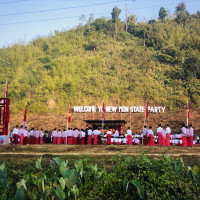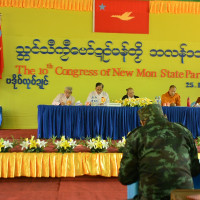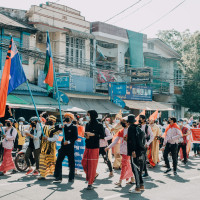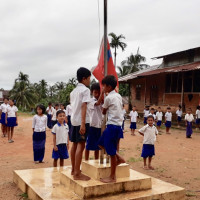No Guns, No Glory: Why the Mon Are Losing Ground in Myanmar A Myanmar Commentary by Sike Chan*
Regiones
On the 78th anniversary of Mon Revolution Day, Sike Chan explains in this commentary why, despite continuing sufferings and endeavours, the Mon cause has failed to make similar ground to other ethnic movements in the aftermath of the SAC coup. Resistance has not ended. But limited in resources, it has proven difficult to build unity and organisation in a country where power, all too often, is decided by military rather than political strength.
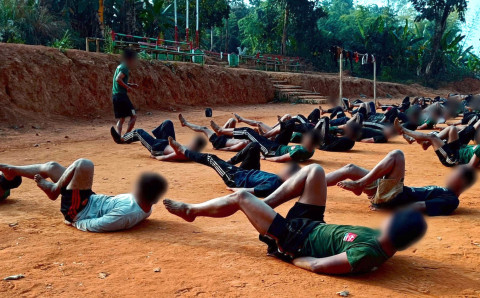
Photo source MLA / ဓာတ်ပုံရင်းမြစ် - မွန်ပြည်လွတ်မြောက်ရေးတပ်တော် (MLA)
More than four years after Myanmar’s 2021 coup sparked the nationwide Spring Revolution, ethnic armed groups across the country have seen varied trajectories. While some have expanded their influence and revived armed resistance, the Mon people – one of Myanmar’s oldest and politically active ethnic communities – have little to show in return. The stark reality is that military might, not democratic aspiration, remains the decisive currency of political relevance in the country today. And on that front, the Mon have been losing ground.
From Dominance to Decline
Armed resistance among the Mon people began at Myanmar’s independence in 1948 when civil war and state breakdown swept the country. Subsequently, the Mon People’s Front (MPF) laid down its arms in 1958 under a political settlement with the central government, disbanding with over 10,000 fighters. Even as late as 1995, the New Mon State Party (NMSP) – the MPF’s successor – maintained a standing force of more than 7,000 troops when it signed a ceasefire with the military regime of the State Law and Order Restoration Council. Today, it struggles to keep 700 troops in uniform.
Despite multiple efforts to rebuild capacity through training programmes and youth outreach, the NMSP’s military relevance has steadily declined until the present day. Cultural factors also play a role: unlike some ethnic armed organisations (EAOs) elsewhere in the country, the Mon have not enforced a “one fighter per family” conscription model. Combined with the allure of economic opportunity in Yangon and abroad, the NMSP finds it hard to recruit new fighters.
What, however, sets Mon resistance apart from stronger EAOs like the United Wa State Army (UWSA) is not just manpower, but finances. Without control over lucrative extractive industries or cross-border trade, the NMSP lacks the economic base to sustain prolonged warfare. Unlike others, it cannot depend on jade, narcotics or arms smuggling. Instead, the Mon movement relies on modest taxation and voluntary donations, which is a fragile and unsustainable model in a land in civil war. In contrast, the neighbouring Karen National Union (KNU) has thrived post-coup, absorbing thousands of disillusioned youth from across the country into its ranks. It now commands enough forces to establish new battalions. From the sidelines, Mon leaders have watched with unease.
A Movement Divided
The power asymmetry between the Mon and other groups like the UWSA or the KNU has prompted reflection, if not reform. At the NMSP’s 11th Party Congress, the party resolved that its military wing – the Mon National Liberation Army (MNLA) – would actively participate in the resistance against the State Adminsitration Council (SAC). But implementation has been uneven.
A faction calling itself the NMSP-Anti-Dictatorship (NMSP-AD) broke away from the main party, aiming to rejuvenate armed resistance and better align with post-coup revolutionary dynamics. Yet their intent was more about revitalizing morale than launching direct offensives. After 30 years of ceasefire, the MNLA’s operational culture is widely considered outdated. Its fighters are unfamiliar with modern revolutionary tactics, and its leadership lack visionary strategy.
In this military vacuum, the Mon Liberation Army (MLA), trained by the Ta’ang National Liberation Army (TNLA), initially offered hope. It had both manpower and equipment. The MLA’s eventual absorption into the NMSP’s fold – facilitated by AD leaders – was seen as a tactical win. However, tensions soon re-emerged. Many of the Local Defense Forces (LDFs), previously aligned with the MLA, found themselves unable to cooperate further once the MLA fell under the influence of the NMSP, whose financial and political dominance (particularly over MLA founders) proved too overwhelming. This shift rendered any potential merger between the LDFs and the MLA effectively unviable.
At present, political and military leadership remains divided between the NMSP-AD bloc and the broader Mon State Federal Council (MSFC), formed post coup, with each side vying for authority. While full unification among Mon armed groups may seem distant, it remains possible in the longer term, especially since many MSFC figures are former NMSP cadres who may eventually return to the party. In that light, the MSFC’s coordination with the National Unity Government (NUG), established by pro-democracy supporters to challenge the rule of the SAC, appears to be a short-term strategic arrangement rather than a permanent break from the NMSP orbit.
An Emerging Generational Divide
Among the younger generation of Mon revolutionaries, there is admiration for the Arakan Army (AA) which, in under two decades, eclipsed older Arakan factions like the Arakan Liberation Party and Arakan National Congress. Many attribute the AA’s meteoric rise to the strategic vision and charisma of Maj-Gen. Twan Mrat Naing, its youthful commander. Yet the Mon movement lacks a comparable figure. Any would-be challenger faces steep obstacles, not least the entrenched dominance of the NMSP. As a local proverb puts it, “Two lions cannot share the same cave.”
In the meantime, Mon youth-led resistance groups have appeared since the 2021 coup, but they are likely to remain marginal in the immediate future. Despite disillusionment with the passive NMSP, there is no widespread civilian support behind these new factions. Most Mon people still view the NMSP – however flawed – as the only credible entity capable of negotiating Mon autonomy within Myanmar’s fractured political landscape.
Elections and the Illusion of Influence
Mon communities across the country are today worried about the weakness of their social and political position. As the military junta of the SAC pushes forward with plans for a sham election, Mon resistance lacks the leverage to block or disrupt the process. Protests and public denouncements have little effect. In Mon State, the junta is thus likely to proceed with relative ease.
This underscores a fundamental contrast between the Mon and Karen experiences. While the KNU’s military wing flourishes but Karen political parties lacks electoral strength, the Mon excel in electoral politics despite weak armed resistance. The Mon Unity Party (MUP) continues to participate in formal politics, while the NMSP positions itself as a peace negotiator – hoping to secure autonomy through dialogue, not force. In this sense, Mon politics appears to be regressing to its pre-2021 status quo: one of limited negotiation, symbolic resistance and political survival.
A Revolution Without Rewards
If one were to ask what the Mon people have gained from the Spring Revolution, the answer remains painfully clear: almost nothing. Armed resistance is fragmented, recruitment is weak, finances are strained, and political influence has not grown. Without decisive leadership, resource control or public backing, the Mon people risk being further sidelined in the country’s fast-evolving ethnic landscape.
Myanmar’s post-coup future remains deeply uncertain. But one thing is evident: in the new revolutionary order, those without guns, funds or charismatic leadership risk becoming footnotes. Unless the Mon movement rethinks its strategies, it may find itself relegated to exactly that.
* Sike Chan is a Research Consultant at the New Rehmonnya Federated Force (NRFF). With academic expertise in International Development and Political Science, his work focuses on Sino-Burma relations, conflict dynamics and security issues in Myanmar. The views and opinions expressed here do not necessarily reflect the policies or positions of the NRFF.
